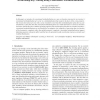Free Online Productivity Tools
i2Speak
i2Symbol
i2OCR
iTex2Img
iWeb2Print
iWeb2Shot
i2Type
iPdf2Split
iPdf2Merge
i2Bopomofo
i2Arabic
i2Style
i2Image
i2PDF
iLatex2Rtf
Sci2ools
CGF
2008
2008
Accelerating Ray Tracing using Constrained Tetrahedralizations
In this paper we introduce the constrained tetrahedralization as a new acceleration structure for ray tracing. A constrained tetrahedralization of a scene is a tetrahedralization that respects the faces of the scene geometry. The closest intersection of a ray with a scene is found by traversing this tetrahedralization along the ray, one tetrahedron at a time. We show that constrained tetrahedralizations are a viable alternative to current acceleration structures, and that they have a number of unique properties that set them apart from other acceleration structures: constrained tetrahedralizations are not hierarchical yet adaptive; the complexity of traversing them is a function of local geometric complexity rather than global geometric complexity; constrained tetrahedralizations support deforming geometry without any effort; and they have the potential to unify several data structures currently used in global illumination. Categories and Subject Descriptors (according to ACM CCS): I....
| Added | 25 Dec 2010 |
| Updated | 25 Dec 2010 |
| Type | Journal |
| Year | 2008 |
| Where | CGF |
| Authors | Ares Lagae, Philip Dutré |
Comments (0)

